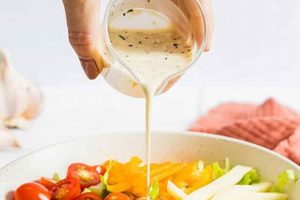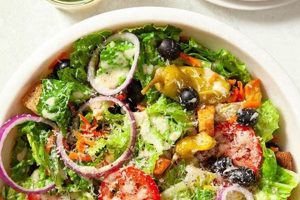Flavorful dressings utilizing fermented soybean paste as a base offer a unique and savory alternative to traditional vinaigrettes. These dressings can range from light and tangy to rich and creamy, incorporating ingredients like rice vinegar, sesame oil, ginger, and citrus. For instance, a simple version might combine white miso paste with rice vinegar, mirin, and a touch of honey.
The umami richness of these dressings complements a wide variety of salad ingredients, from crisp greens and vegetables to heartier grains and proteins. Beyond their flavor contribution, they also offer potential health benefits associated with fermented foods, such as improved digestion and gut health. Historically, miso has played a significant role in various Asian cuisines, and its incorporation into contemporary dressings showcases its versatility and enduring appeal.
This article will further explore various formulation approaches, ingredient pairings, and techniques for crafting exceptional dressings featuring this versatile ingredient. From classic combinations to innovative flavor profiles, readers will discover how to elevate their salads with the unique savoriness of fermented soybean paste.
Tips for Crafting Exceptional Miso Dressings
Achieving a well-balanced and flavorful dressing requires attention to detail and an understanding of key ingredient interactions. These tips offer guidance for creating dressings that enhance, rather than overpower, salad components.
Tip 1: Start with Quality Miso: The type of miso paste significantly impacts the final flavor profile. White (shiro) miso offers a mild, sweeter taste, while red (aka) miso possesses a more intense, salty flavor. Consider the other salad ingredients when selecting a miso paste.
Tip 2: Balance Sweet and Savory: Miso’s inherent saltiness benefits from a touch of sweetness. Ingredients like honey, maple syrup, or mirin can achieve this balance. Start small and adjust to taste.
Tip 3: Incorporate Acidity: Rice vinegar, lime juice, or lemon juice provide necessary acidity to brighten the dressing and cut through the richness of the miso. Experiment to find preferred flavor combinations.
Tip 4: Enhance with Aromatics: Grated ginger, minced garlic, or finely chopped shallots add depth and complexity. These aromatics can be incorporated directly into the dressing or used as a garnish.
Tip 5: Emulsify for a Smooth Texture: Whisking the dressing vigorously while slowly drizzling in oil creates a smooth, emulsified texture that clings to salad ingredients. A neutral oil like grapeseed or canola oil works well.
Tip 6: Taste and Adjust: Before serving, taste the dressing and adjust seasonings as needed. A pinch of salt, a squeeze of citrus, or a touch more sweetener can make a significant difference.
Tip 7: Consider Texture: Toasted sesame seeds, crushed peanuts, or a drizzle of chili oil can add textural contrast and visual appeal to the finished salad.
By following these guidelines, one can create dressings that showcase the versatility and depth of flavor miso offers, resulting in a truly enhanced dining experience.
This exploration of techniques and flavor combinations provides a foundation for creating exceptional dressings tailored to individual preferences and culinary creativity.
1. Miso Type
Miso paste, a fermented soybean product, forms the foundation of these dressings, contributing a unique umami richness and depth of flavor. The specific type of miso employed significantly influences the final character of the dressing, impacting its taste, color, and overall suitability for various salad ingredients.
- White (Shiro) Miso
Characterized by its mild, sweet flavor and light color, white miso is fermented for a shorter period than other varieties. This results in a delicate flavor profile that complements lighter salads featuring spring greens, cucumbers, and delicate herbs. Its lower salt content allows for greater flexibility in balancing sweetness and acidity within the dressing.
- Yellow (Shinshu) Miso
Occupying a middle ground between white and red miso, yellow miso offers a balanced flavor profile with moderate saltiness and subtle sweetness. Its versatility makes it suitable for a wider range of salads, pairing well with both lighter and more robust ingredients such as roasted vegetables, grilled tofu, or chicken.
- Red (Aka) Miso
With its deep red color and intense, savory flavor, red miso undergoes a longer fermentation process, resulting in a pronounced umami character and higher salt content. This robust flavor profile pairs well with heartier salads featuring ingredients like kale, mushrooms, and seared meats. Careful balancing of other ingredients is crucial to avoid overpowering the other salad components.
- Blended Misos (Awase)
Combining different miso varieties offers further complexity and allows for customized flavor profiles. Blending white and red miso, for instance, can create a dressing with balanced sweetness and savory notes. This approach encourages experimentation and tailoring the dressing to specific salad compositions.
Careful consideration of miso type is paramount in crafting a well-balanced and flavorful dressing. Understanding the nuances of each variety allows for informed decisions regarding ingredient pairings and the overall composition of the salad, ensuring a harmonious and enjoyable culinary experience.
2. Acidity
Acidity plays a crucial role in miso salad dressings, providing balance, brightness, and enhancing the overall flavor profile. The inherent richness and umami notes of miso benefit significantly from a counterpoint of acidity, which prevents the dressing from becoming overly heavy or cloying. This balance is achieved through the incorporation of acidic ingredients, primarily vinegars and citrus juices. The specific type of acid employed influences the final taste and complements different salad components. For instance, rice vinegar contributes a mild, slightly sweet acidity that harmonizes well with delicate greens and vegetables, while a more assertive rice wine vinegar provides a sharper contrast to richer ingredients like roasted vegetables or grilled tofu. Similarly, citrus juices, such as lemon or lime, offer a vibrant, refreshing acidity that brightens the dressing and adds a layer of complexity. The interplay between the savory miso and the chosen acidic element creates a dynamic flavor profile that elevates the salad beyond a simple combination of ingredients.
The level of acidity also requires careful consideration. Too little acidity can result in a bland, one-dimensional dressing, while excessive acidity can overpower the other flavors and create an unpleasant sharpness. The ideal balance depends on the specific miso paste used, other ingredients in the dressing, and the overall composition of the salad. Experimentation and tasting are essential to achieving the desired result. A general guideline involves starting with a smaller amount of acid and gradually increasing until the optimal balance is reached. Adjusting the acidity allows for fine-tuning the dressing to complement the specific ingredients and create a harmonious flavor profile.
Understanding the function and impact of acidity in miso salad dressings is essential for crafting exceptional culinary creations. The careful selection and balancing of acidic ingredients contribute significantly to the overall taste, texture, and enjoyment of the salad. Through considered experimentation and a nuanced approach to flavor pairings, one can harness the power of acidity to create dressings that enhance the dining experience and showcase the versatility of miso as a culinary ingredient.
3. Sweetener Balance
Sweetener balance in miso salad dressings is crucial for achieving a harmonious flavor profile. The inherent saltiness and umami of miso require a counterpoint of sweetness to prevent the dressing from becoming overly savory or one-dimensional. This balance is achieved through the judicious use of various sweeteners, each contributing unique characteristics to the final product.
- Honey
Honey offers a natural sweetness with subtle floral notes, complementing the earthy flavors of miso. Its viscosity also contributes to the texture of the dressing, adding a pleasant richness. Different varieties of honey, such as clover or wildflower, can introduce subtle flavor variations.
- Maple Syrup
Maple syrup provides a distinct sweetness with hints of caramel and woodsy notes. Its robust flavor profile pairs well with bolder miso varieties and complements salads featuring roasted vegetables or nuts. The intensity of maple syrup can be adjusted based on grade and preference.
- Mirin
Mirin, a Japanese sweet rice wine, adds a subtle sweetness and a touch of umami to the dressing. Its lower viscosity compared to honey or maple syrup creates a lighter texture, suitable for dressings intended for delicate greens or salads with a higher water content. Mirin also contributes a subtle sheen to the finished product.
- Agave Nectar
Agave nectar offers a neutral sweetness with a mild flavor profile, allowing the miso and other ingredients to take center stage. Its lower viscosity compared to honey or maple syrup contributes to a thinner dressing consistency. Agave’s neutral flavor makes it a versatile option for a wide range of salad combinations.
The specific sweetener chosen and its quantity significantly impact the final character of the miso salad dressing. Careful consideration of the other ingredients and the desired flavor profile is essential for achieving optimal balance. Experimentation and tasting are encouraged to fine-tune the sweetness and create a dressing that complements the overall composition of the salad.
4. Oil Selection
Oil selection significantly impacts the flavor, texture, and overall quality of miso salad dressings. The oil acts as a carrier for the other ingredients, distributing flavors throughout the salad and contributing to the final mouthfeel. Different oils possess unique flavor profiles and characteristics that interact with the miso and other components, influencing the final outcome. Neutral oils, such as grapeseed or canola, allow the miso and other flavors to shine without introducing competing tastes. Their light texture creates a smooth, emulsified dressing that coats salad ingredients evenly. Conversely, more flavorful oils, like sesame or toasted sesame, contribute nutty, aromatic notes that complement the umami of miso, particularly in dressings intended for Asian-inspired salads. Olive oil, with its fruity and slightly peppery notes, can also be used, but requires careful consideration of the other ingredients to ensure flavor compatibility. For example, a delicate white miso dressing might be overwhelmed by a robust extra virgin olive oil, while a heartier red miso dressing could benefit from the added complexity. The viscosity of the oil also plays a role in the final texture of the dressing. Lighter oils create thinner dressings, suitable for delicate greens, while thicker oils contribute to a richer, more substantial mouthfeel appropriate for heartier salads.
The ratio of oil to other ingredients influences the dressing’s consistency and how it clings to salad components. A higher oil content creates a thinner dressing, while a lower oil content results in a thicker, more viscous emulsion. Emulsification, achieved by whisking the oil slowly into the other ingredients, is crucial for creating a stable and homogenous dressing that doesn’t separate. Proper emulsification ensures that the flavors are evenly distributed and the dressing coats the salad ingredients effectively. Furthermore, the oil’s smoke point should be considered, especially if the dressing will be used in a warm salad or as a marinade. Oils with lower smoke points, like unrefined sesame oil, are not suitable for high-heat applications, while oils with higher smoke points, such as grapeseed or avocado oil, can withstand higher temperatures without degrading.
Selecting the appropriate oil is essential for achieving a well-balanced and flavorful miso salad dressing. Careful consideration of flavor profiles, viscosity, emulsification properties, and intended application ensures that the chosen oil complements the other ingredients and enhances the overall dining experience. A thoughtful approach to oil selection elevates the dressing beyond a simple condiment and transforms it into an integral component of a well-crafted salad.
5. Additional Ingredients
Additional ingredients in miso salad dressings contribute significantly to flavor complexity, textural variation, and overall culinary appeal. These additions expand beyond the core components of miso, acid, sweetener, and oil, offering opportunities for customization and creative expression. The careful selection and incorporation of these supplementary ingredients elevate the dressing from a simple condiment to a nuanced element that enhances the entire salad experience. For example, fresh herbs like cilantro, mint, or chives introduce bright, herbaceous notes that contrast with the savory miso. Spices such as ginger, garlic, or chili flakes add warmth, pungency, and depth of flavor. Toasted sesame seeds, chopped nuts, or black pepper provide textural contrast and visual interest. These additions interact synergistically with the core ingredients, creating a multi-layered flavor profile tailored to specific preferences and salad compositions.
The choice of additional ingredients should align with the overall flavor profile of the salad and the specific type of miso used. A delicate white miso dressing might benefit from subtle additions like grated ginger and chopped chives, while a more robust red miso dressing could accommodate bolder flavors like toasted sesame oil and chili garlic paste. The quantity of additional ingredients is also crucial, as excessive additions can overpower the delicate balance of flavors. A measured approach, starting with small amounts and adjusting to taste, ensures that the additional ingredients enhance rather than dominate the overall composition. Furthermore, the timing of incorporation matters. Delicate herbs might be best added just before serving to preserve their freshness and vibrancy, while spices can be incorporated earlier to allow their flavors to meld with the other ingredients.
Understanding the role and impact of additional ingredients is essential for crafting well-balanced and flavorful miso salad dressings. These additions provide a platform for culinary creativity and customization, allowing for the development of unique flavor profiles that complement a wide range of salad ingredients. A thoughtful approach to incorporating additional ingredients elevates the dressing from a functional component to a defining element of a memorable culinary experience. Balancing flavor profiles, textures, and aromas results in a dressing that enhances the overall enjoyment and appreciation of the salad.
Frequently Asked Questions
This section addresses common inquiries regarding the preparation and utilization of miso-based salad dressings.
Question 1: How long can miso salad dressing be stored?
Properly stored in an airtight container in the refrigerator, miso-based dressings typically last for up to one week. Separation may occur due to the natural ingredients; whisk gently before serving.
Question 2: Can miso salad dressing be used as a marinade?
The robust umami and balanced flavors of miso dressings make them excellent marinades for various proteins, including tofu, chicken, and fish. Marinating times may vary depending on the protein’s density.
Question 3: What types of salads pair best with miso dressings?
Miso dressings complement a wide array of salads, from those featuring delicate greens and vegetables to heartier compositions incorporating grains, roasted vegetables, or seared proteins. The specific miso type within the dressing further influences ideal pairings.
Question 4: Can different types of miso be combined in a single dressing?
Combining miso varieties allows for nuanced flavor profiles. Blending white and red miso, for instance, can create a balanced dressing with both sweet and savory notes.
Question 5: How can one adjust the thickness of a miso salad dressing?
Dressing consistency can be adjusted by altering the oil-to-other-ingredients ratio. More oil creates a thinner dressing, while less oil yields a thicker consistency. A small amount of water can also be added for a thinner dressing.
Question 6: Are there gluten-free miso options available for dressings?
While traditional miso is typically made with barley or rice koji (a starter culture), gluten-free miso varieties made with chickpea or soybean koji are available, allowing for gluten-free dressing preparation.
These responses provide a foundational understanding of miso salad dressing preparation and usage. Experimentation and adaptation based on individual preferences are encouraged.
The following section provides several specific recipe examples to further illustrate the versatility and potential of miso-based dressings.
Miso Salad Dressing Recipes
Exploration of miso salad dressing recipes reveals a versatile culinary landscape. From the foundational role of miso paste to the nuanced interplay of acidity, sweetness, and additional ingredients, the potential for flavor customization is extensive. Careful consideration of miso type, oil selection, and complementary components allows for the creation of dressings tailored to a wide range of salad compositions and individual preferences. The balance of these elements is paramount, ensuring a harmonious and enjoyable dining experience. Furthermore, the adaptability of miso dressings extends beyond salads, showcasing their potential as marinades and flavor enhancers for various culinary applications.
The continued exploration and adaptation of miso salad dressing recipes offer a pathway to innovative culinary creations. By understanding the core principles and embracing experimentation, individuals can unlock the full potential of miso’s unique umami richness and elevate salads from simple accompaniments to culinary centerpieces.






